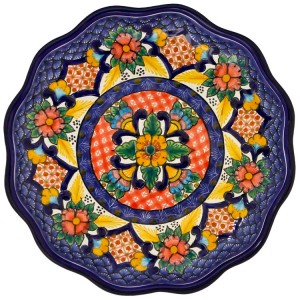 In the early 20th century, interest developed in collecting Talavera Pottery. In 1904, an American by the name of Emily Johnston de Forrest discovered Talavera on a trip to Mexico. She became interested in collecting the works, so she consulted scholars, local collectors and dealers. Eventually, her collection became the base of what is currently exhibited in theMetropolitan Museum of Art in New York. Her enthusiasm was passed onto Edwin Atlee Barber, the curator of the Pennsylvania Museum of Art. He, too, spent time in Mexico and introduced Talavera into the Pennsylvania museum’s collection. He studied the major stylistic periods and how to distinguish the best examples, publishing a guide in 1908 which is still considered authoritative.
In the early 20th century, interest developed in collecting Talavera Pottery. In 1904, an American by the name of Emily Johnston de Forrest discovered Talavera on a trip to Mexico. She became interested in collecting the works, so she consulted scholars, local collectors and dealers. Eventually, her collection became the base of what is currently exhibited in theMetropolitan Museum of Art in New York. Her enthusiasm was passed onto Edwin Atlee Barber, the curator of the Pennsylvania Museum of Art. He, too, spent time in Mexico and introduced Talavera into the Pennsylvania museum’s collection. He studied the major stylistic periods and how to distinguish the best examples, publishing a guide in 1908 which is still considered authoritative.
During this time period, important museum collections were being assembled in Mexico as well. One of the earliest and most important was the collection of Francisco Perez Salazer in Mexico City. A bit later, in the 1920s, Franz Mayer, a German-born stockbroker, started his collection. In Puebla, he was considered a bit crazy for buying all of the “old stuff” from the locals. In 1986, the Franz Mayer Museum opened in Mexico City with the largest collection of Talavera Poblana in the world – 726 pieces from the 17th through the 19th century, and some 20th-century pieces by Enrique Luis Ventosa. In Puebla, José Luis Bello y González and his son José Mariano Bello y Acedo sought the advice of Ventosa in starting their collection. They amassed the largest and most important collection in the city which now is housed in the José Luis Bello y González Museum (Bello Museum).
More recently, the Museo de la Talavera (Talavera Museum) has been established in the city of Puebla, with an initial collection of 400 pieces. The museum is dedicated to recounting the origins, history, expansions and variations in the craft. Pieces include some of the simplest and most complex, as well as those representing different eras.
Several temporary and travelling exhibits of certain themes have been created from these permanent collections. One of these was called “El Aguila en la Historia de Mexico” (The Eagle in the History of Mexico). The forty-two-piece exhibit was sponsored by the Senate of Mexico to show how the eagle symbol has been used in the country throughout its history. This exhibit was sponsored in honor of the Bicentennial of Independence in 2010. These ceramics were chosen because of their combination of art and utility. Eagles depicted include that of Mexico’s coat of arms, as well as those of political figures such as José María Morelos y Pavón and Porfirio Díaz, and those used by institutions such as the Royal and Pontifical University of Mexico and the Mexican Senate itself.
Another exhibit in Mexico centered on the creation of maps using Talavera tile. Most tiles during the colonial period were decorated with flowers and landscapes but a significant number were painted to create murals with maps. Those that survive show how a number of cities developed over the colonial period. Eight of the most representative 16th-century Talavera tile maps were at the El Carmen Museum at an exhibit called “Cartografia: Una Vision en Talavera del Mexico Colonial” (Cartography: A Talavera Vision of Colonial Mexico). This exhibit was of reproductions of the originals created by the Talavera de la Luz workshop in Puebla. The chosen maps show the development of Mexico City as well as representations of the Acapulco, Puebla and the Tesuco regions during this time period.
Exhibits have been held outside of Mexico as well. The Museum of the Americas in Spain held an exhibit called “Talaveras de Puebla, Cerámica colonial Mexicana. Siglos XVII a XXI” (Talavera Pottery of Puebla, Mexican colonial ceramics, XVII to 21st centuries). This was a temporary exhibit of 49 pieces, combined with pieces from Spain and China as references. The pieces were loaned by the Franz Mayer Museum and the Bello Museum.
